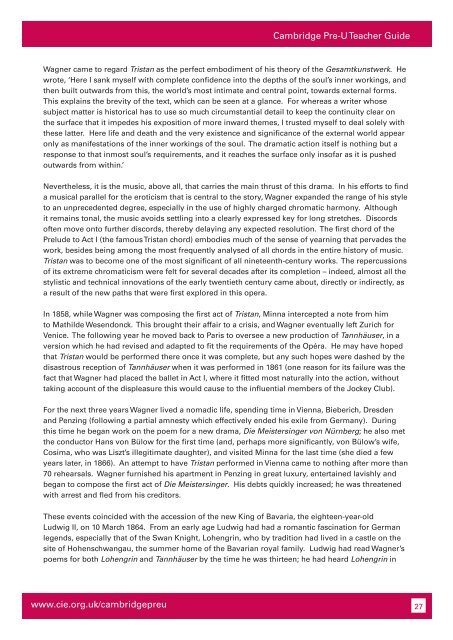Teacher's Guide Cambridge Pre-U MUSIC Available for teaching ...
Teacher's Guide Cambridge Pre-U MUSIC Available for teaching ...
Teacher's Guide Cambridge Pre-U MUSIC Available for teaching ...
You also want an ePaper? Increase the reach of your titles
YUMPU automatically turns print PDFs into web optimized ePapers that Google loves.
<strong>Cambridge</strong> <strong>Pre</strong>-U Teacher <strong>Guide</strong><br />
Wagner came to regard Tristan as the perfect embodiment of his theory of the Gesamtkunstwerk. He<br />
wrote, ‘Here I sank myself with complete confidence into the depths of the soul’s inner workings, and<br />
then built outwards from this, the world’s most intimate and central point, towards external <strong>for</strong>ms.<br />
This explains the brevity of the text, which can be seen at a glance. For whereas a writer whose<br />
subject matter is historical has to use so much circumstantial detail to keep the continuity clear on<br />
the surface that it impedes his exposition of more inward themes, I trusted myself to deal solely with<br />
these latter. Here life and death and the very existence and significance of the external world appear<br />
only as manifestations of the inner workings of the soul. The dramatic action itself is nothing but a<br />
response to that inmost soul’s requirements, and it reaches the surface only insofar as it is pushed<br />
outwards from within.’<br />
Nevertheless, it is the music, above all, that carries the main thrust of this drama. In his ef<strong>for</strong>ts to find<br />
a musical parallel <strong>for</strong> the eroticism that is central to the story, Wagner expanded the range of his style<br />
to an unprecedented degree, especially in the use of highly charged chromatic harmony. Although<br />
it remains tonal, the music avoids settling into a clearly expressed key <strong>for</strong> long stretches. Discords<br />
often move onto further discords, thereby delaying any expected resolution. The first chord of the<br />
<strong>Pre</strong>lude to Act I (the famous Tristan chord) embodies much of the sense of yearning that pervades the<br />
work, besides being among the most frequently analysed of all chords in the entire history of music.<br />
Tristan was to become one of the most significant of all nineteenth-century works. The repercussions<br />
of its extreme chromaticism were felt <strong>for</strong> several decades after its completion – indeed, almost all the<br />
stylistic and technical innovations of the early twentieth century came about, directly or indirectly, as<br />
a result of the new paths that were first explored in this opera.<br />
In 1858, while Wagner was composing the first act of Tristan, Minna intercepted a note from him<br />
to Mathilde Wesendonck. This brought their affair to a crisis, and Wagner eventually left Zurich <strong>for</strong><br />
Venice. The following year he moved back to Paris to oversee a new production of Tannhäuser, in a<br />
version which he had revised and adapted to fit the requirements of the Opéra. He may have hoped<br />
that Tristan would be per<strong>for</strong>med there once it was complete, but any such hopes were dashed by the<br />
disastrous reception of Tannhäuser when it was per<strong>for</strong>med in 1861 (one reason <strong>for</strong> its failure was the<br />
fact that Wagner had placed the ballet in Act I, where it fitted most naturally into the action, without<br />
taking account of the displeasure this would cause to the influential members of the Jockey Club).<br />
For the next three years Wagner lived a nomadic life, spending time in Vienna, Bieberich, Dresden<br />
and Penzing (following a partial amnesty which effectively ended his exile from Germany). During<br />
this time he began work on the poem <strong>for</strong> a new drama, Die Meistersinger von Nürnberg; he also met<br />
the conductor Hans von Bülow <strong>for</strong> the first time (and, perhaps more significantly, von Bülow’s wife,<br />
Cosima, who was Liszt’s illegitimate daughter), and visited Minna <strong>for</strong> the last time (she died a few<br />
years later, in 1866). An attempt to have Tristan per<strong>for</strong>med in Vienna came to nothing after more than<br />
70 rehearsals. Wagner furnished his apartment in Penzing in great luxury, entertained lavishly and<br />
began to compose the first act of Die Meistersinger. His debts quickly increased; he was threatened<br />
with arrest and fled from his creditors.<br />
These events coincided with the accession of the new King of Bavaria, the eighteen-year-old<br />
Ludwig II, on 10 March 1864. From an early age Ludwig had had a romantic fascination <strong>for</strong> German<br />
legends, especially that of the Swan Knight, Lohengrin, who by tradition had lived in a castle on the<br />
site of Hohenschwangau, the summer home of the Bavarian royal family. Ludwig had read Wagner’s<br />
poems <strong>for</strong> both Lohengrin and Tannhäuser by the time he was thirteen; he had heard Lohengrin in<br />
www.cie.org.uk/cambridgepreu 27
















